Logistics & Operations: Intermodal Challenges & Solutions in NSW
VerifiedAdded on 2023/06/11
|8
|2230
|418
Report
AI Summary
This report identifies challenges in New South Wales' logistics networks, particularly congestion in ports like Port Jackson, Port Kembla, and Port Botany. It explores issues such as inadequate land for logistics development in Western Sydney and ethical concerns related to companies like Zara. The report also discusses the impact of the new intermodal terminal in Moorebank and the concerns raised by the Liverpool council regarding health hazards and traffic congestion. Solutions include leveraging the intermodal logistics hub in the Southern Highlands, improving access to the Sydney intermodal, and enhancing workforce capabilities through Transport for NSW. The role of the New South Wales government is highlighted, including initiatives like Public-Private Partnerships and expansion of port facilities. The report concludes by emphasizing the government's practical involvement in addressing these challenges through sustainable measures.
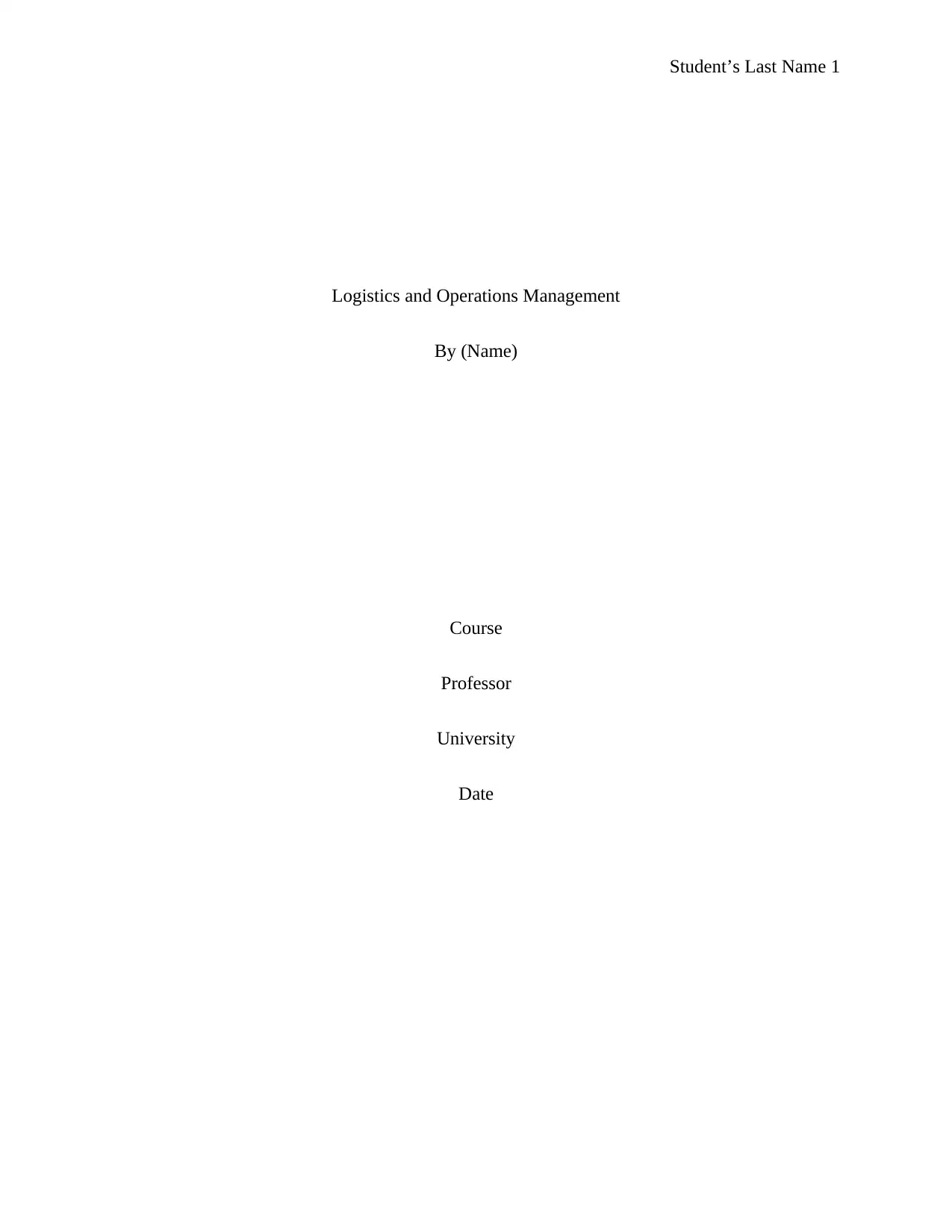
Student’s Last Name 1
Logistics and Operations Management
By (Name)
Course
Professor
University
Date
Logistics and Operations Management
By (Name)
Course
Professor
University
Date
Paraphrase This Document
Need a fresh take? Get an instant paraphrase of this document with our AI Paraphraser
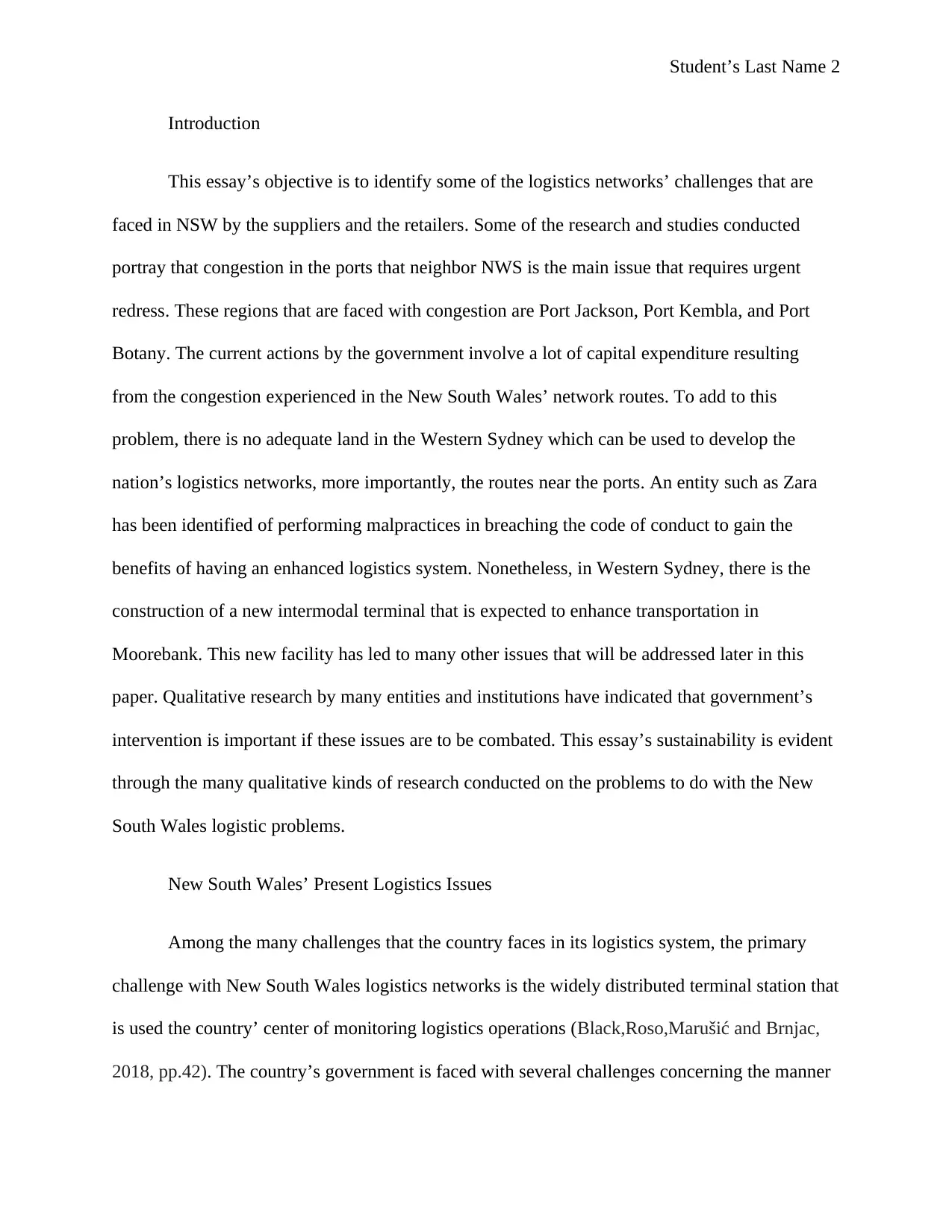
Student’s Last Name 2
Introduction
This essay’s objective is to identify some of the logistics networks’ challenges that are
faced in NSW by the suppliers and the retailers. Some of the research and studies conducted
portray that congestion in the ports that neighbor NWS is the main issue that requires urgent
redress. These regions that are faced with congestion are Port Jackson, Port Kembla, and Port
Botany. The current actions by the government involve a lot of capital expenditure resulting
from the congestion experienced in the New South Wales’ network routes. To add to this
problem, there is no adequate land in the Western Sydney which can be used to develop the
nation’s logistics networks, more importantly, the routes near the ports. An entity such as Zara
has been identified of performing malpractices in breaching the code of conduct to gain the
benefits of having an enhanced logistics system. Nonetheless, in Western Sydney, there is the
construction of a new intermodal terminal that is expected to enhance transportation in
Moorebank. This new facility has led to many other issues that will be addressed later in this
paper. Qualitative research by many entities and institutions have indicated that government’s
intervention is important if these issues are to be combated. This essay’s sustainability is evident
through the many qualitative kinds of research conducted on the problems to do with the New
South Wales logistic problems.
New South Wales’ Present Logistics Issues
Among the many challenges that the country faces in its logistics system, the primary
challenge with New South Wales logistics networks is the widely distributed terminal station that
is used the country’ center of monitoring logistics operations (Black,Roso,Marušić and Brnjac,
2018, pp.42). The country’s government is faced with several challenges concerning the manner
Introduction
This essay’s objective is to identify some of the logistics networks’ challenges that are
faced in NSW by the suppliers and the retailers. Some of the research and studies conducted
portray that congestion in the ports that neighbor NWS is the main issue that requires urgent
redress. These regions that are faced with congestion are Port Jackson, Port Kembla, and Port
Botany. The current actions by the government involve a lot of capital expenditure resulting
from the congestion experienced in the New South Wales’ network routes. To add to this
problem, there is no adequate land in the Western Sydney which can be used to develop the
nation’s logistics networks, more importantly, the routes near the ports. An entity such as Zara
has been identified of performing malpractices in breaching the code of conduct to gain the
benefits of having an enhanced logistics system. Nonetheless, in Western Sydney, there is the
construction of a new intermodal terminal that is expected to enhance transportation in
Moorebank. This new facility has led to many other issues that will be addressed later in this
paper. Qualitative research by many entities and institutions have indicated that government’s
intervention is important if these issues are to be combated. This essay’s sustainability is evident
through the many qualitative kinds of research conducted on the problems to do with the New
South Wales logistic problems.
New South Wales’ Present Logistics Issues
Among the many challenges that the country faces in its logistics system, the primary
challenge with New South Wales logistics networks is the widely distributed terminal station that
is used the country’ center of monitoring logistics operations (Black,Roso,Marušić and Brnjac,
2018, pp.42). The country’s government is faced with several challenges concerning the manner
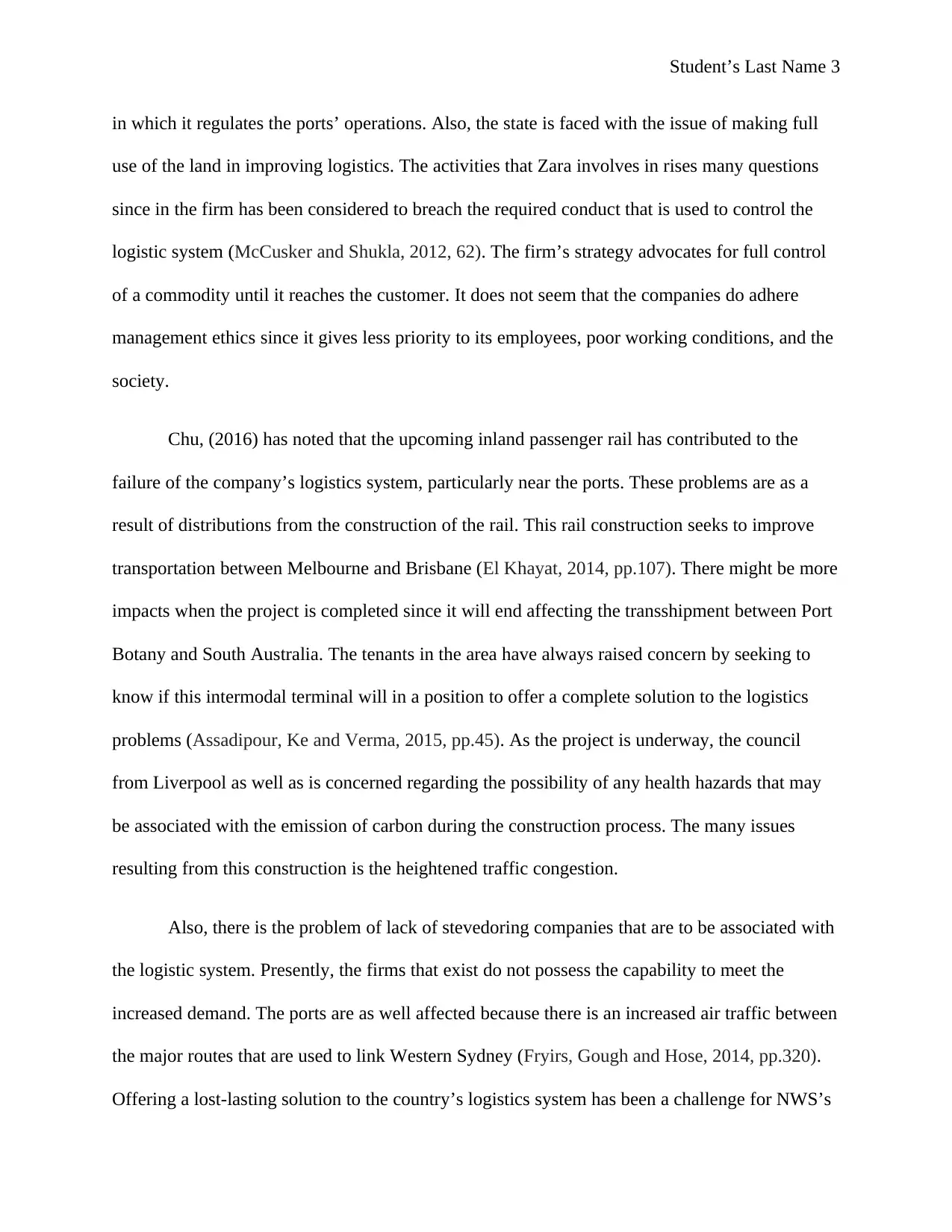
Student’s Last Name 3
in which it regulates the ports’ operations. Also, the state is faced with the issue of making full
use of the land in improving logistics. The activities that Zara involves in rises many questions
since in the firm has been considered to breach the required conduct that is used to control the
logistic system (McCusker and Shukla, 2012, 62). The firm’s strategy advocates for full control
of a commodity until it reaches the customer. It does not seem that the companies do adhere
management ethics since it gives less priority to its employees, poor working conditions, and the
society.
Chu, (2016) has noted that the upcoming inland passenger rail has contributed to the
failure of the company’s logistics system, particularly near the ports. These problems are as a
result of distributions from the construction of the rail. This rail construction seeks to improve
transportation between Melbourne and Brisbane (El Khayat, 2014, pp.107). There might be more
impacts when the project is completed since it will end affecting the transshipment between Port
Botany and South Australia. The tenants in the area have always raised concern by seeking to
know if this intermodal terminal will in a position to offer a complete solution to the logistics
problems (Assadipour, Ke and Verma, 2015, pp.45). As the project is underway, the council
from Liverpool as well as is concerned regarding the possibility of any health hazards that may
be associated with the emission of carbon during the construction process. The many issues
resulting from this construction is the heightened traffic congestion.
Also, there is the problem of lack of stevedoring companies that are to be associated with
the logistic system. Presently, the firms that exist do not possess the capability to meet the
increased demand. The ports are as well affected because there is an increased air traffic between
the major routes that are used to link Western Sydney (Fryirs, Gough and Hose, 2014, pp.320).
Offering a lost-lasting solution to the country’s logistics system has been a challenge for NWS’s
in which it regulates the ports’ operations. Also, the state is faced with the issue of making full
use of the land in improving logistics. The activities that Zara involves in rises many questions
since in the firm has been considered to breach the required conduct that is used to control the
logistic system (McCusker and Shukla, 2012, 62). The firm’s strategy advocates for full control
of a commodity until it reaches the customer. It does not seem that the companies do adhere
management ethics since it gives less priority to its employees, poor working conditions, and the
society.
Chu, (2016) has noted that the upcoming inland passenger rail has contributed to the
failure of the company’s logistics system, particularly near the ports. These problems are as a
result of distributions from the construction of the rail. This rail construction seeks to improve
transportation between Melbourne and Brisbane (El Khayat, 2014, pp.107). There might be more
impacts when the project is completed since it will end affecting the transshipment between Port
Botany and South Australia. The tenants in the area have always raised concern by seeking to
know if this intermodal terminal will in a position to offer a complete solution to the logistics
problems (Assadipour, Ke and Verma, 2015, pp.45). As the project is underway, the council
from Liverpool as well as is concerned regarding the possibility of any health hazards that may
be associated with the emission of carbon during the construction process. The many issues
resulting from this construction is the heightened traffic congestion.
Also, there is the problem of lack of stevedoring companies that are to be associated with
the logistic system. Presently, the firms that exist do not possess the capability to meet the
increased demand. The ports are as well affected because there is an increased air traffic between
the major routes that are used to link Western Sydney (Fryirs, Gough and Hose, 2014, pp.320).
Offering a lost-lasting solution to the country’s logistics system has been a challenge for NWS’s
⊘ This is a preview!⊘
Do you want full access?
Subscribe today to unlock all pages.

Trusted by 1+ million students worldwide
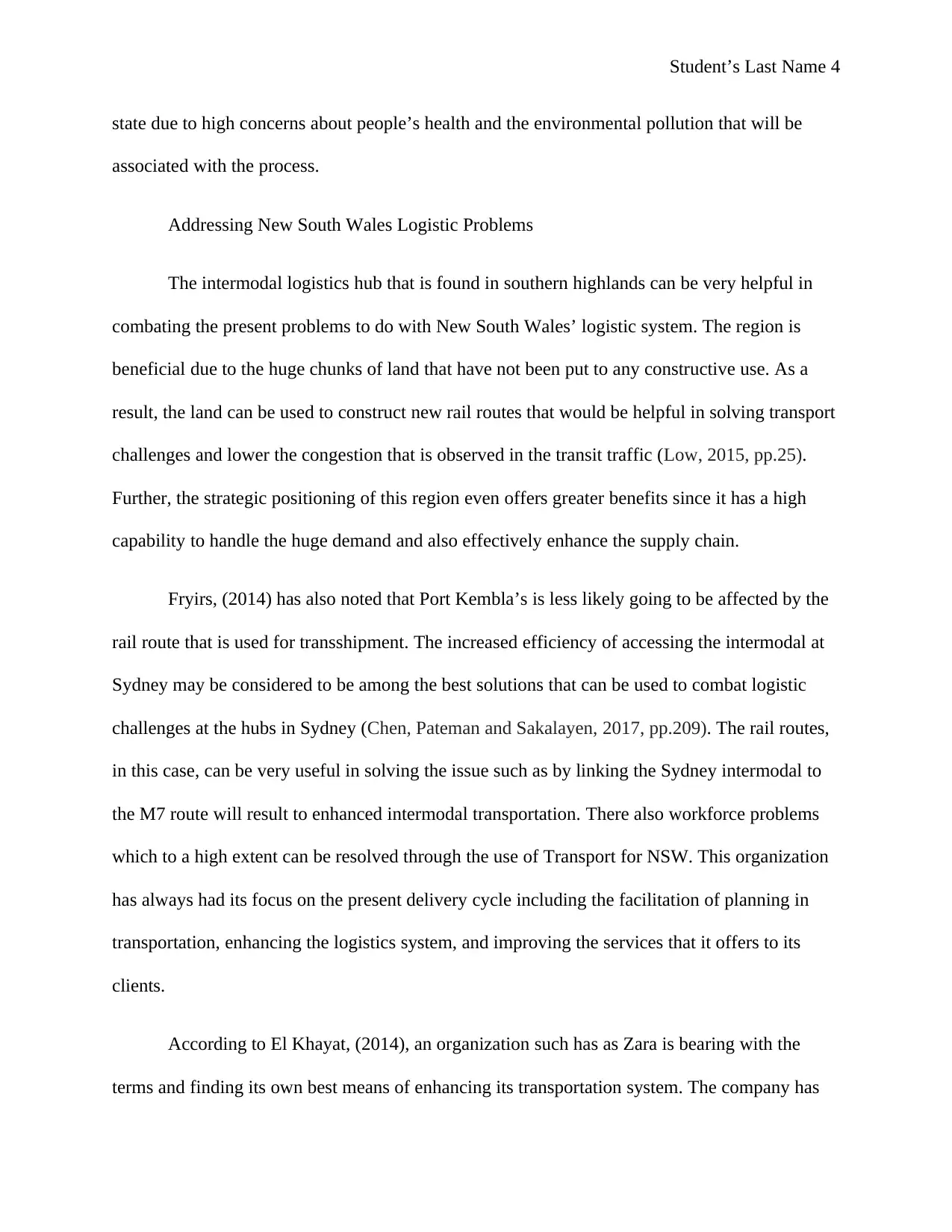
Student’s Last Name 4
state due to high concerns about people’s health and the environmental pollution that will be
associated with the process.
Addressing New South Wales Logistic Problems
The intermodal logistics hub that is found in southern highlands can be very helpful in
combating the present problems to do with New South Wales’ logistic system. The region is
beneficial due to the huge chunks of land that have not been put to any constructive use. As a
result, the land can be used to construct new rail routes that would be helpful in solving transport
challenges and lower the congestion that is observed in the transit traffic (Low, 2015, pp.25).
Further, the strategic positioning of this region even offers greater benefits since it has a high
capability to handle the huge demand and also effectively enhance the supply chain.
Fryirs, (2014) has also noted that Port Kembla’s is less likely going to be affected by the
rail route that is used for transshipment. The increased efficiency of accessing the intermodal at
Sydney may be considered to be among the best solutions that can be used to combat logistic
challenges at the hubs in Sydney (Chen, Pateman and Sakalayen, 2017, pp.209). The rail routes,
in this case, can be very useful in solving the issue such as by linking the Sydney intermodal to
the M7 route will result to enhanced intermodal transportation. There also workforce problems
which to a high extent can be resolved through the use of Transport for NSW. This organization
has always had its focus on the present delivery cycle including the facilitation of planning in
transportation, enhancing the logistics system, and improving the services that it offers to its
clients.
According to El Khayat, (2014), an organization such has as Zara is bearing with the
terms and finding its own best means of enhancing its transportation system. The company has
state due to high concerns about people’s health and the environmental pollution that will be
associated with the process.
Addressing New South Wales Logistic Problems
The intermodal logistics hub that is found in southern highlands can be very helpful in
combating the present problems to do with New South Wales’ logistic system. The region is
beneficial due to the huge chunks of land that have not been put to any constructive use. As a
result, the land can be used to construct new rail routes that would be helpful in solving transport
challenges and lower the congestion that is observed in the transit traffic (Low, 2015, pp.25).
Further, the strategic positioning of this region even offers greater benefits since it has a high
capability to handle the huge demand and also effectively enhance the supply chain.
Fryirs, (2014) has also noted that Port Kembla’s is less likely going to be affected by the
rail route that is used for transshipment. The increased efficiency of accessing the intermodal at
Sydney may be considered to be among the best solutions that can be used to combat logistic
challenges at the hubs in Sydney (Chen, Pateman and Sakalayen, 2017, pp.209). The rail routes,
in this case, can be very useful in solving the issue such as by linking the Sydney intermodal to
the M7 route will result to enhanced intermodal transportation. There also workforce problems
which to a high extent can be resolved through the use of Transport for NSW. This organization
has always had its focus on the present delivery cycle including the facilitation of planning in
transportation, enhancing the logistics system, and improving the services that it offers to its
clients.
According to El Khayat, (2014), an organization such has as Zara is bearing with the
terms and finding its own best means of enhancing its transportation system. The company has
Paraphrase This Document
Need a fresh take? Get an instant paraphrase of this document with our AI Paraphraser
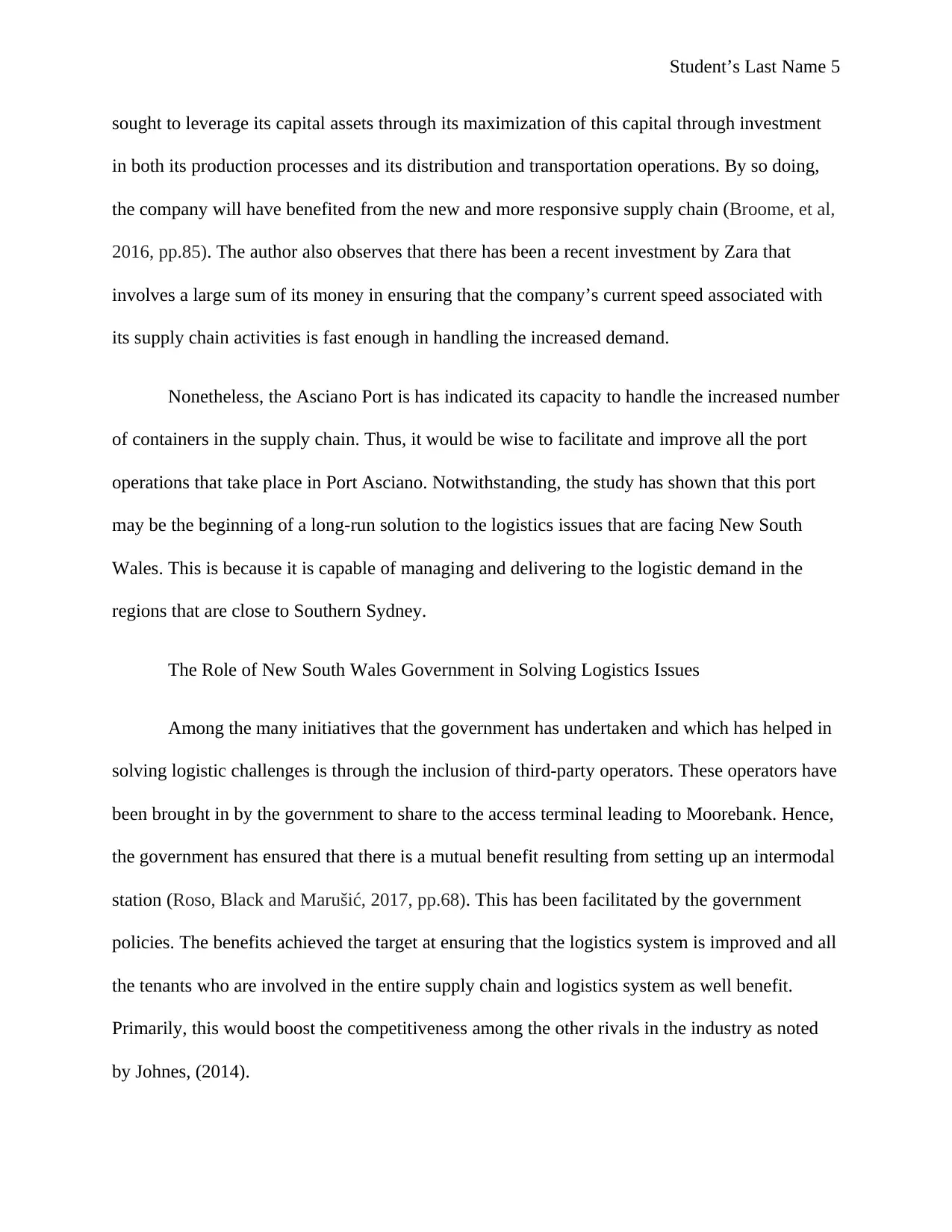
Student’s Last Name 5
sought to leverage its capital assets through its maximization of this capital through investment
in both its production processes and its distribution and transportation operations. By so doing,
the company will have benefited from the new and more responsive supply chain (Broome, et al,
2016, pp.85). The author also observes that there has been a recent investment by Zara that
involves a large sum of its money in ensuring that the company’s current speed associated with
its supply chain activities is fast enough in handling the increased demand.
Nonetheless, the Asciano Port is has indicated its capacity to handle the increased number
of containers in the supply chain. Thus, it would be wise to facilitate and improve all the port
operations that take place in Port Asciano. Notwithstanding, the study has shown that this port
may be the beginning of a long-run solution to the logistics issues that are facing New South
Wales. This is because it is capable of managing and delivering to the logistic demand in the
regions that are close to Southern Sydney.
The Role of New South Wales Government in Solving Logistics Issues
Among the many initiatives that the government has undertaken and which has helped in
solving logistic challenges is through the inclusion of third-party operators. These operators have
been brought in by the government to share to the access terminal leading to Moorebank. Hence,
the government has ensured that there is a mutual benefit resulting from setting up an intermodal
station (Roso, Black and Marušić, 2017, pp.68). This has been facilitated by the government
policies. The benefits achieved the target at ensuring that the logistics system is improved and all
the tenants who are involved in the entire supply chain and logistics system as well benefit.
Primarily, this would boost the competitiveness among the other rivals in the industry as noted
by Johnes, (2014).
sought to leverage its capital assets through its maximization of this capital through investment
in both its production processes and its distribution and transportation operations. By so doing,
the company will have benefited from the new and more responsive supply chain (Broome, et al,
2016, pp.85). The author also observes that there has been a recent investment by Zara that
involves a large sum of its money in ensuring that the company’s current speed associated with
its supply chain activities is fast enough in handling the increased demand.
Nonetheless, the Asciano Port is has indicated its capacity to handle the increased number
of containers in the supply chain. Thus, it would be wise to facilitate and improve all the port
operations that take place in Port Asciano. Notwithstanding, the study has shown that this port
may be the beginning of a long-run solution to the logistics issues that are facing New South
Wales. This is because it is capable of managing and delivering to the logistic demand in the
regions that are close to Southern Sydney.
The Role of New South Wales Government in Solving Logistics Issues
Among the many initiatives that the government has undertaken and which has helped in
solving logistic challenges is through the inclusion of third-party operators. These operators have
been brought in by the government to share to the access terminal leading to Moorebank. Hence,
the government has ensured that there is a mutual benefit resulting from setting up an intermodal
station (Roso, Black and Marušić, 2017, pp.68). This has been facilitated by the government
policies. The benefits achieved the target at ensuring that the logistics system is improved and all
the tenants who are involved in the entire supply chain and logistics system as well benefit.
Primarily, this would boost the competitiveness among the other rivals in the industry as noted
by Johnes, (2014).
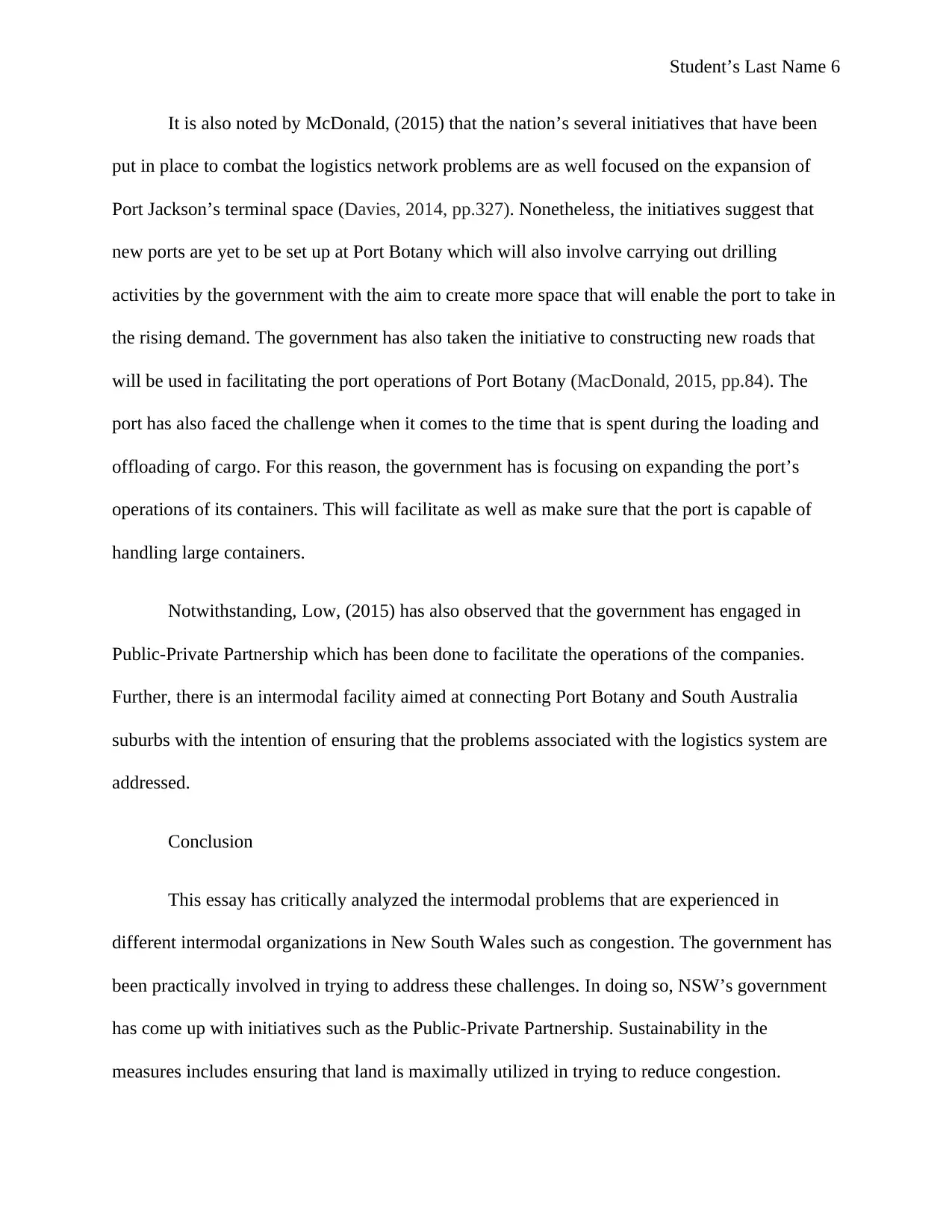
Student’s Last Name 6
It is also noted by McDonald, (2015) that the nation’s several initiatives that have been
put in place to combat the logistics network problems are as well focused on the expansion of
Port Jackson’s terminal space (Davies, 2014, pp.327). Nonetheless, the initiatives suggest that
new ports are yet to be set up at Port Botany which will also involve carrying out drilling
activities by the government with the aim to create more space that will enable the port to take in
the rising demand. The government has also taken the initiative to constructing new roads that
will be used in facilitating the port operations of Port Botany (MacDonald, 2015, pp.84). The
port has also faced the challenge when it comes to the time that is spent during the loading and
offloading of cargo. For this reason, the government has is focusing on expanding the port’s
operations of its containers. This will facilitate as well as make sure that the port is capable of
handling large containers.
Notwithstanding, Low, (2015) has also observed that the government has engaged in
Public-Private Partnership which has been done to facilitate the operations of the companies.
Further, there is an intermodal facility aimed at connecting Port Botany and South Australia
suburbs with the intention of ensuring that the problems associated with the logistics system are
addressed.
Conclusion
This essay has critically analyzed the intermodal problems that are experienced in
different intermodal organizations in New South Wales such as congestion. The government has
been practically involved in trying to address these challenges. In doing so, NSW’s government
has come up with initiatives such as the Public-Private Partnership. Sustainability in the
measures includes ensuring that land is maximally utilized in trying to reduce congestion.
It is also noted by McDonald, (2015) that the nation’s several initiatives that have been
put in place to combat the logistics network problems are as well focused on the expansion of
Port Jackson’s terminal space (Davies, 2014, pp.327). Nonetheless, the initiatives suggest that
new ports are yet to be set up at Port Botany which will also involve carrying out drilling
activities by the government with the aim to create more space that will enable the port to take in
the rising demand. The government has also taken the initiative to constructing new roads that
will be used in facilitating the port operations of Port Botany (MacDonald, 2015, pp.84). The
port has also faced the challenge when it comes to the time that is spent during the loading and
offloading of cargo. For this reason, the government has is focusing on expanding the port’s
operations of its containers. This will facilitate as well as make sure that the port is capable of
handling large containers.
Notwithstanding, Low, (2015) has also observed that the government has engaged in
Public-Private Partnership which has been done to facilitate the operations of the companies.
Further, there is an intermodal facility aimed at connecting Port Botany and South Australia
suburbs with the intention of ensuring that the problems associated with the logistics system are
addressed.
Conclusion
This essay has critically analyzed the intermodal problems that are experienced in
different intermodal organizations in New South Wales such as congestion. The government has
been practically involved in trying to address these challenges. In doing so, NSW’s government
has come up with initiatives such as the Public-Private Partnership. Sustainability in the
measures includes ensuring that land is maximally utilized in trying to reduce congestion.
⊘ This is a preview!⊘
Do you want full access?
Subscribe today to unlock all pages.

Trusted by 1+ million students worldwide
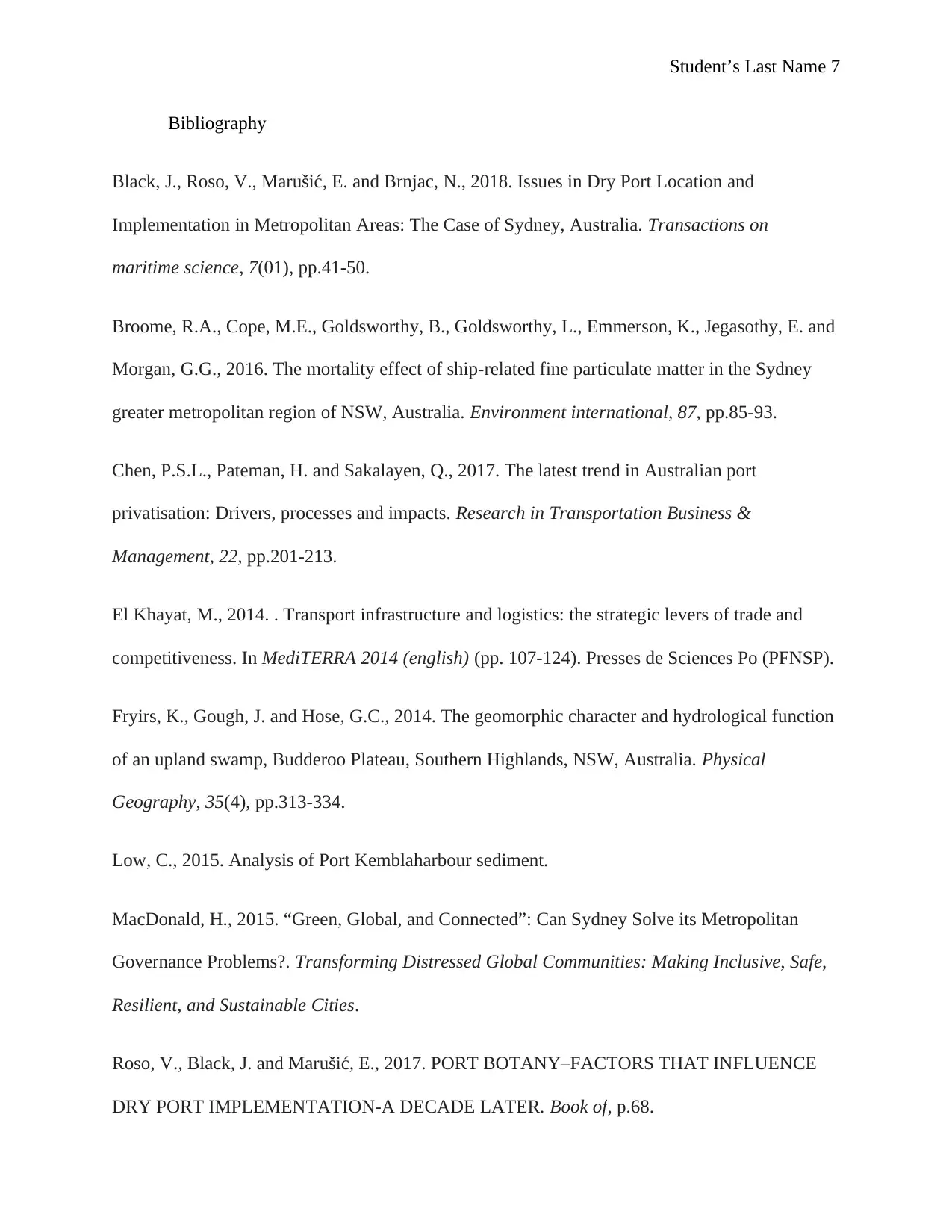
Student’s Last Name 7
Bibliography
Black, J., Roso, V., Marušić, E. and Brnjac, N., 2018. Issues in Dry Port Location and
Implementation in Metropolitan Areas: The Case of Sydney, Australia. Transactions on
maritime science, 7(01), pp.41-50.
Broome, R.A., Cope, M.E., Goldsworthy, B., Goldsworthy, L., Emmerson, K., Jegasothy, E. and
Morgan, G.G., 2016. The mortality effect of ship-related fine particulate matter in the Sydney
greater metropolitan region of NSW, Australia. Environment international, 87, pp.85-93.
Chen, P.S.L., Pateman, H. and Sakalayen, Q., 2017. The latest trend in Australian port
privatisation: Drivers, processes and impacts. Research in Transportation Business &
Management, 22, pp.201-213.
El Khayat, M., 2014. . Transport infrastructure and logistics: the strategic levers of trade and
competitiveness. In MediTERRA 2014 (english) (pp. 107-124). Presses de Sciences Po (PFNSP).
Fryirs, K., Gough, J. and Hose, G.C., 2014. The geomorphic character and hydrological function
of an upland swamp, Budderoo Plateau, Southern Highlands, NSW, Australia. Physical
Geography, 35(4), pp.313-334.
Low, C., 2015. Analysis of Port Kemblaharbour sediment.
MacDonald, H., 2015. “Green, Global, and Connected”: Can Sydney Solve its Metropolitan
Governance Problems?. Transforming Distressed Global Communities: Making Inclusive, Safe,
Resilient, and Sustainable Cities.
Roso, V., Black, J. and Marušić, E., 2017. PORT BOTANY–FACTORS THAT INFLUENCE
DRY PORT IMPLEMENTATION-A DECADE LATER. Book of, p.68.
Bibliography
Black, J., Roso, V., Marušić, E. and Brnjac, N., 2018. Issues in Dry Port Location and
Implementation in Metropolitan Areas: The Case of Sydney, Australia. Transactions on
maritime science, 7(01), pp.41-50.
Broome, R.A., Cope, M.E., Goldsworthy, B., Goldsworthy, L., Emmerson, K., Jegasothy, E. and
Morgan, G.G., 2016. The mortality effect of ship-related fine particulate matter in the Sydney
greater metropolitan region of NSW, Australia. Environment international, 87, pp.85-93.
Chen, P.S.L., Pateman, H. and Sakalayen, Q., 2017. The latest trend in Australian port
privatisation: Drivers, processes and impacts. Research in Transportation Business &
Management, 22, pp.201-213.
El Khayat, M., 2014. . Transport infrastructure and logistics: the strategic levers of trade and
competitiveness. In MediTERRA 2014 (english) (pp. 107-124). Presses de Sciences Po (PFNSP).
Fryirs, K., Gough, J. and Hose, G.C., 2014. The geomorphic character and hydrological function
of an upland swamp, Budderoo Plateau, Southern Highlands, NSW, Australia. Physical
Geography, 35(4), pp.313-334.
Low, C., 2015. Analysis of Port Kemblaharbour sediment.
MacDonald, H., 2015. “Green, Global, and Connected”: Can Sydney Solve its Metropolitan
Governance Problems?. Transforming Distressed Global Communities: Making Inclusive, Safe,
Resilient, and Sustainable Cities.
Roso, V., Black, J. and Marušić, E., 2017. PORT BOTANY–FACTORS THAT INFLUENCE
DRY PORT IMPLEMENTATION-A DECADE LATER. Book of, p.68.
Paraphrase This Document
Need a fresh take? Get an instant paraphrase of this document with our AI Paraphraser
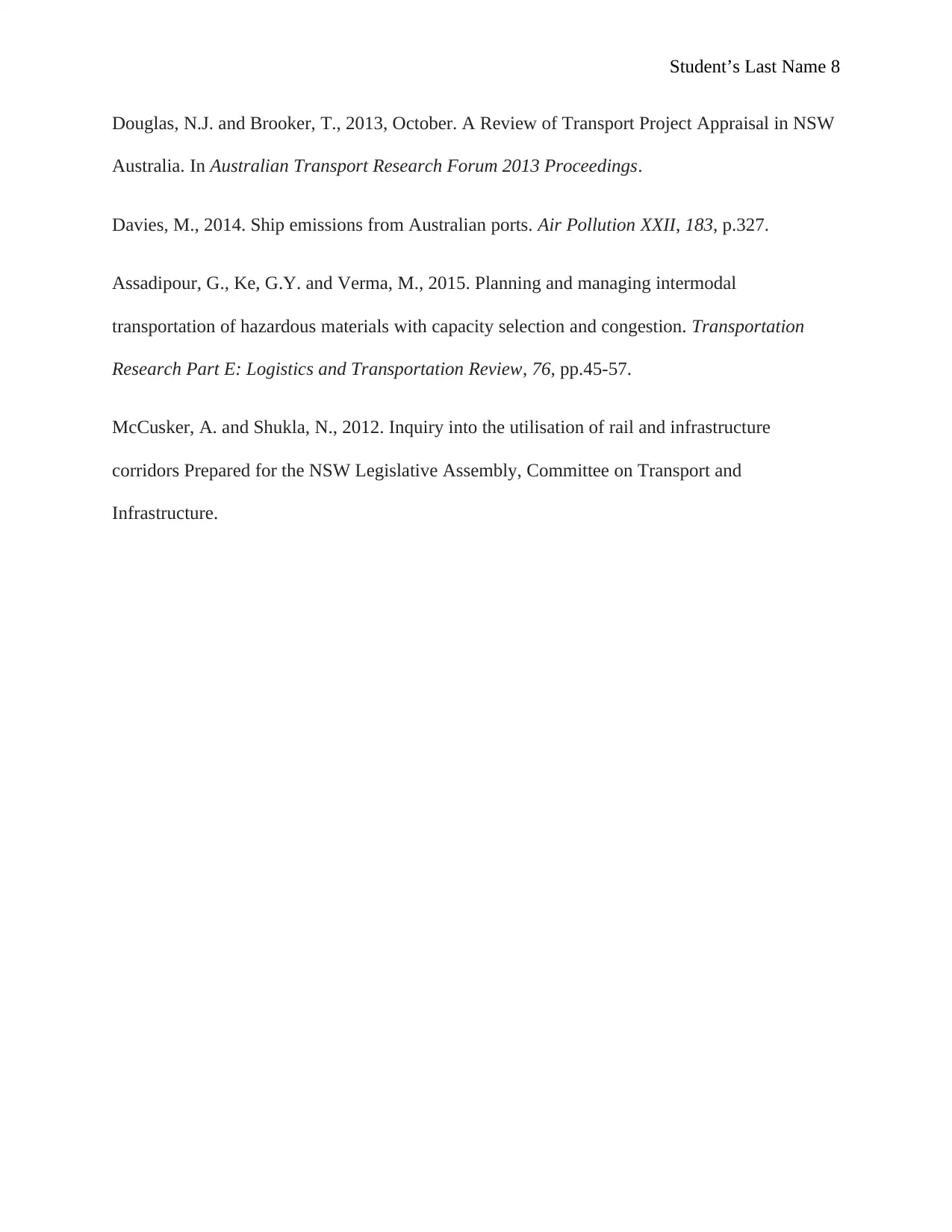
Student’s Last Name 8
Douglas, N.J. and Brooker, T., 2013, October. A Review of Transport Project Appraisal in NSW
Australia. In Australian Transport Research Forum 2013 Proceedings.
Davies, M., 2014. Ship emissions from Australian ports. Air Pollution XXII, 183, p.327.
Assadipour, G., Ke, G.Y. and Verma, M., 2015. Planning and managing intermodal
transportation of hazardous materials with capacity selection and congestion. Transportation
Research Part E: Logistics and Transportation Review, 76, pp.45-57.
McCusker, A. and Shukla, N., 2012. Inquiry into the utilisation of rail and infrastructure
corridors Prepared for the NSW Legislative Assembly, Committee on Transport and
Infrastructure.
Douglas, N.J. and Brooker, T., 2013, October. A Review of Transport Project Appraisal in NSW
Australia. In Australian Transport Research Forum 2013 Proceedings.
Davies, M., 2014. Ship emissions from Australian ports. Air Pollution XXII, 183, p.327.
Assadipour, G., Ke, G.Y. and Verma, M., 2015. Planning and managing intermodal
transportation of hazardous materials with capacity selection and congestion. Transportation
Research Part E: Logistics and Transportation Review, 76, pp.45-57.
McCusker, A. and Shukla, N., 2012. Inquiry into the utilisation of rail and infrastructure
corridors Prepared for the NSW Legislative Assembly, Committee on Transport and
Infrastructure.
1 out of 8
Related Documents
Your All-in-One AI-Powered Toolkit for Academic Success.
+13062052269
info@desklib.com
Available 24*7 on WhatsApp / Email
![[object Object]](/_next/static/media/star-bottom.7253800d.svg)
Unlock your academic potential
Copyright © 2020–2025 A2Z Services. All Rights Reserved. Developed and managed by ZUCOL.


